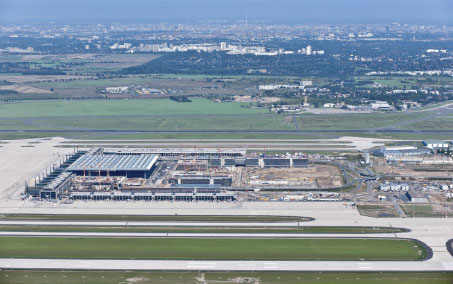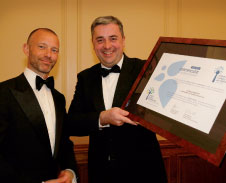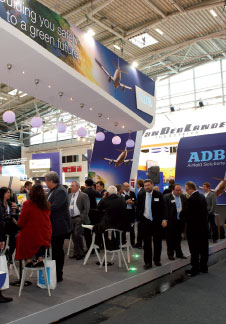
Heimberg: “Berlin Brandenburg Airport will be approximately 27% more efficient than required by law in 2007, when planning started.” (Photo: Günter Wicker)
The construction of the new Berlin Brandenburg Airport, the £1.2 billion (€1.4 billion) redevelopment of Gatwick Airport, and the investment in developing facilities at Frankfurt Airport currently represent three of the most significant industry projects in Europe.
While all of the projects are centred on enhancing facilities in order to provide more efficient operations and an improved customer experience, an environmental focus has been placed at the heart of each of them to both satisfy ‘green’ regulations and to set a benchmark for future developments.
Frankfurt Airport
At Frankfurt Airport, the environmental responsibility lies with the Sustainability Board and the Sustainability Working Group, which are responsible for ensuring that the environmental impact of the development and operation of the airport is minimised.
“Two years ago, Fraport undertook a reorganisation with the environmental division placed next to the social and economic divisions,” said Dr. Peter Marx, Head of Environmental Management, Sustainability Management Division, Fraport. “The idea was to link the sustainable principles throughout the company with the stakeholders and the critical partners.”
Earlier this year, Frankfurt Airport – the very first airport to become Airport Carbon Accredited after ACI EUROPE launched the programme in 2009 – achieved the ‘Reduction’ level of accreditation and is progressing well in its efforts to achieve the third level – ‘Optimisation’ – in 2012.
One of Fraport’s key targets is to reduce CO2 emissions per passenger and per 100kg of freight by 30% by 2020. To help achieve this, a 20% reduction in CO2 emissions for Terminal 1 is planned, the new Pier A-Plus will be an energy-optimised building, and the construction of Fire Station 4 has seen the introduction of Fraport’s first carbon neutral building.
London-Gatwick
The redevelopment of Gatwick Airport entails a multitude of various projects, ranging from the extension of the North Terminal and refurbishment of the South Terminal, to the redevelopment of the airfield, which includes the complete resurfacing of the runway.
As each of the projects have been ongoing, the airport has also this year become Airport Carbon Accredited at the ‘Reduction’ level, while it is the largest UK airport to have achieved both the Carbon Trust Standard and ISO 14001 accreditation.
Doug Waters, Best Practice Manager, Gatwick Airport, said “We are focusing on three key areas: energy, materials and waste. A lot of what we’re trying to do is understand how much energy is being used and, importantly, where. Every time we undertake a new project, we make sure we can get a better handle on the energy data as this then allows us to understand what energy levels we need to set for the new buildings and how we can make savings.”
For each of the projects, the airport also undertakes a Sustainability Assessment Process, while a Sustainable Material Strategy has been developed to outline which materials the airport expects its construction suppliers to use.
Berlin Brandenburg Airport
Meanwhile, in Berlin, the construction of the German capital city’s brand new airport is nearing completion. It is currently the largest airport construction site in Europe but on 3 June 2012, the airport – which includes a six-storey, 280,000sqm terminal situated between two parallel runways – will become operational. Upon the opening, the existing Schönefeld Airport will cease operations, while Tegel Airport will also close. This follows the closure of Tempelhof Airport in 2008.
Jochen Heimberg, Head of the Environment Department of Berlin Brandenburg Airport, said: “Environmental sustainability is a key issue for Berlin Airports. Berlin Brandenburg Airport will thus be approximately 27% more efficient than required by law in 2007, when planning started.”
New power generators have been installed on the site of the new airport, while thanks to energy supply contracting, it will be supplied with heating, cooling and electric energy for a 15-year period. This energy will be supplied through trigeneration, gas-powered cogeneration modules providing electricity and heat, and use of heat and cold water storage modules.

Stewart Wingate, CEO Gatwick Airport (right) receives Gatwick's Airport Carbon Accreditation certificate at the ‘Reduction’ level from Olivier Jankovec, Director General of ACI EUROPE.
“A further 50% of energy will be obtained in the form of certified electricity from renewable sources,” Heimberg added. Supplying the new airport with environmentally-friendly energy and building a new energy efficient terminal will lead to approximately 53% less CO2 emissions in its first year of operation compared to the two existing airports in 2010.
“The launch and certification of an integrated environmental and energy management system in accordance with ISO 14001 and 50001 is planned to coincide with the opening of the new airport. This system will help increase CO2 savings potential through a process of continuous optimisation,” Heimberg said.
Providing an example of how CO2 emissions will be reduced wherever possible, an innovative air conditioning system in the passenger terminal will allow for annual savings of around 53,000 MWh/a of heating, cooling and electric energy compared to conventional designs.
Long-term strategies
Renewable energy sources are also central to the environmental strategies at Frankfurt and Gatwick airports. In fact, the former plans to supply a percentage of its energy requirements using geothermal heat in combination with biogas, and has launched a joint venture with RWE’s D&S Geo Innogy GmbH subsidiary to explore the potential of the Walldorf deep-earth geothermal field near the airport.

All of ADB Airfield Solutions’ LED innovations and associated products and systems were on display at Inter Airport 2011.
Meanwhile, Gatwick Airport’s Waters explained: “We’re looking to set up our own energy centres to generate our own electricity, heat and so on, and we’ll be able to manage these ourselves.”
With Airport Collaborative Decision-Making (A-CDM) also playing an increasing role in helping airports and their key stakeholders reduce their environmental footprint, Gatwick Airport is currently undertaking the implementation process, while Frankfurt Airport has already achieved full implementation. “A-CDM has a very strong influence on the working practices of the groups in and around the airport,” Marx said.
As development works continue at Frankfurt and Gatwick airports, as well as the new Berlin Brandenburg Airport, environmental efficiency continues to play a key role. While a large part of the focus is currently on ensuring that the development works themselves have a minimal impact on the surrounding environment, the long-term strategies that have been developed will ensure that the environment remains at the heart of daily operations and any further development plans.
ADB enjoys successful Inter Airport 2011
Airport experts are confident that this year’s Inter Airport show – in Munich, Germany – has sent out positive signals for the future of the airport sector. A total of 606 exhibitors from 34 countries, and more than 12,600 visitors attended this leading international exhibition for the airport industry. ADB Airfield Solutions, one of the global market leaders in Airfield Ground Lights (AGL), certainly made an impact with its exhibition stand.
All of ADB Airfield Solutions’ LED innovations and associated products and systems were on display.
New products, such as the EREL/ERES High Intensity LED Runway Edge fittings or the Airfield Sensor, drew a lot of interest. Live demos of the AGLAS (Individual Lamp Control and Monitoring System) and APS (Advanced Power Supply) systems were regularly requested. The new AD range of LED inset lights for taxiway and for high intensity runway applications incorporated in the demonstration of the AGLAS system had visitors commenting on the neat design and the extremely good light output.
Visitors interested in reducing CO2 emissions were pleased to see ADB’s Solar Range, a partnership with Carmanah. The Solar Aviation Wireless LED (SAWL) and the Solar Runway Guard Light System were both on show.
A surprise to many visitors was the world standard FMT Docking Guidance system being displayed, thanks to a recent cooperation agreement with FMT, a technological leader in VDGS (visual docking guidance system).







